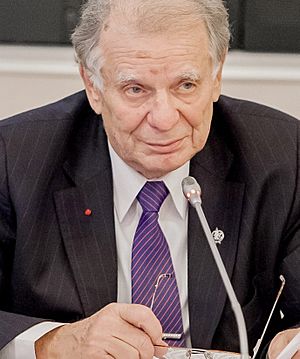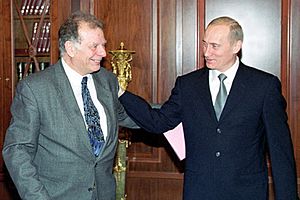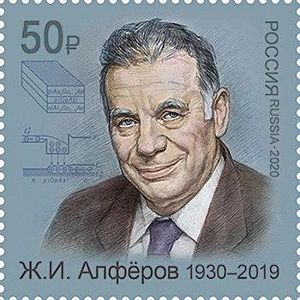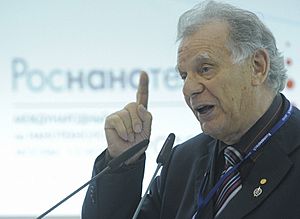Zhores Alferov facts for kids
Quick facts for kids
Zhores Alferov
|
|
|---|---|

Alferov in 2012
|
|
| Born |
Zhores Ivanovich Alferov
15 March 1930 |
| Died | 1 March 2019 (aged 88) St Petersburg, Russia
|
| Nationality | Soviet (until 1991) / Russian (since 1991) |
| Alma mater | Saint Petersburg State Electrotechnical University "LETI" (old name V. I. Ulyanov Electrotechnical Institute "LETI") |
| Known for | Heterotransistors |
| Awards | Global Energy Prize (2005) Kyoto Prize in Advanced Technology (2001) Nobel Prize in Physics (2000) Demidov Prize (1999) Ioffe Prize (Russian Academy of Sciences, 1996) USSR State Prize (1984) Lenin Prize (1972) Stuart Ballantine Medal (1971) Order of Lenin (1986) |
| Scientific career | |
| Fields | Applied physics |
| Institutions | Ioffe Physico-Technical Institute |
| Thesis | Heterojunctions in semiconductors (1970) |
Zhores Ivanovich Alferov (born March 15, 1930 – died March 1, 2019) was an important Soviet and Russian physicist. He made big contributions to the science of modern heterostructures and electronics.
He won the 2000 Nobel Prize in Physics. He shared it for helping to create the semiconductor heterojunction. This invention is used in optoelectronics, which combines optics (light) and electronics. Later in his life, he also became a politician. He served in the State Duma, which is part of the Russian parliament. He was a member of the Communist Party from 1995.
Contents
Early Life and Education
Zhores Alferov was born in Vitebsk, which was then part of the Byelorussian SSR in the Soviet Union. His father, Ivan Karpovich Alferov, managed a factory. His mother was Anna Vladimirovna Rosenblum. Zhores was named after a French socialist named Jean Jaurès. His older brother was named Marx, after Karl Marx.
Alferov finished high school in Minsk in 1947. He then started studying at the Belarusian Polytechnic Academy. In 1952, he earned his bachelor's degree from the V. I. Ulyanov (Lenin) Electrotechnical Institute (LETI) in Leningrad.
Starting in 1953, Alferov began working at the Ioffe Physico-Technical Institute. This institute was part of the Academy of Sciences of the Soviet Union. He earned more science degrees from this institute. He received a Candidate of Sciences in Technology in 1961. Then, he earned a Doctor of Sciences in Physics and Mathematics in 1970.
Alferov later became the director of the Ioffe Institute. He held this position from 1987 to 2003. In 1972, he was chosen as a corresponding member of the Academy of Sciences of the Soviet Union. He became a full member in 1979. From 1989, he was also the Vice-President of the USSR Academy of Sciences. He was also the President of its Saint Petersburg Scientific Center.
Groundbreaking Research
When Alferov started at the Ioffe Institute in 1953, he joined a team led by Vladimir Tuchkevich. This team worked on special devices called planar semiconductor amplifiers. These were used in radio receivers. Today, we call these devices transistors. Alferov helped develop germanium diodes, which are used to change alternating current into direct current.
In the early 1960s, Alferov started a project at the Ioffe Institute. The goal was to create semiconductor heterostructures. Think of a heterostructure as a sandwich made of different semiconductor materials. These new semiconductor heterojunction transistors could work at much higher frequencies. This was a huge step forward. This ability is very important for modern mobile phones and satellite communication.
Alferov and his team focused on making heterojunctions using materials like GaAs and AlAs. They especially wanted to use heterojunctions to create semiconductor lasers. These lasers could work at room temperature. In 1963, Alferov applied for a patent for double-heterostructure lasers. Another scientist, Herbert Kroemer, also filed a similar patent around the same time.
In 1966, Alferov's lab made the first lasers based on heterostructures. These lasers did not work continuously at first. Then, in 1968, Alferov and his coworkers made the first continuous-wave semiconductor heterojunction laser. This laser could operate at room temperature. This was a major breakthrough. It happened just one month before other scientists at Bell Labs achieved the same thing.
This important work earned Alferov the 2000 Nobel Prize in Physics. He shared it with Herbert Kroemer. The prize was for "developing semiconductor heterostructures used in high-speed- and optoelectronics."
Throughout the 1960s and 1970s, Alferov continued his research. He studied the physics and technology of semiconductor heterostructures. His work on how semiconductors inject electricity and his contributions to lasers, solar cells, LEDs (light-emitting diodes), and epitaxy processes led to modern heterojunction physics and electronics.
The invention of semiconductor heterojunctions changed how semiconductors were designed. It quickly led to many useful products. These include LEDs, barcode readers, and CDs. Hermann Grimmeiss, from the Royal Swedish Academy of Sciences, said that without Alferov's work, it would be impossible to send information from satellites to Earth. He also said we wouldn't have so many telephone lines between cities.
Alferov believed heterostructures were incredibly important. He wrote that this progress would shape the future of solid-state physics. He also felt it would affect the future of human society itself.
Leading Scientific Institutions
In 1987, Alferov became the fifth director of the Ioffe Institute. In 1989, he also became the chairman of the Leningrad Scientific Center. This center is now called the St. Petersburg Scientific Center. It is a large organization that includes 70 different scientific institutions, organizations, and businesses.
As a director and chairman, Alferov worked hard to support scientific research. This was especially important during a time when Russia's political and economic situation was changing.
Alferov also wanted to connect schools with scientific research centers. He believed this would help train the next generation of scientists. He was inspired by Peter the Great's idea for the Russian Academy of Sciences. Peter the Great wanted the Academy to have a strong research core that worked closely with secondary schools.
In 1987, Alferov and his colleagues at the Ioffe Institute opened a secondary school in Saint Petersburg. It was called the School of Physics and Technology. In 1997, Alferov founded the Research and Education Center at the Ioffe Institute. In 2002, this center officially became a new university, the Saint Petersburg Academic University. It was allowed to give master's and PhD degrees. In 2009, the university was reorganized. The School of Physics and Technology became part of the university. This helped link scientific education even more closely to research.
In the 2000s, Alferov used his roles in academics and parliament to promote nanotechnology in Russia. Nanotechnology is about working with very tiny materials. The main research goal of the Saint Petersburg Academic University, which Alferov founded, was to develop nanotechnology. Alferov often spoke in parliament about the need for more money for science. In 2006, Prime Minister Mikhail Fradkov announced the creation of a federal agency called Rosnanotekh. This agency was created to develop nanotechnology applications.
Political Involvement

Alferov was elected to the Russian Parliament, known as the State Duma, in 1995. He was a representative for the political party Our Home – Russia. This party generally supported the policies of President Boris Yeltsin.
In 1999, he was elected again. This time, he was on the list for the Communist Party of the Russian Federation. He was re-elected in 2003 and again in 2007. Even though he was not officially a member of the Communist Party, he was placed second on their election list.
Alferov was one of the scientists who signed an Open letter to President Vladimir V. Putin. This letter was against the growing influence of religion in Russia. Alferov was an atheist, meaning he did not believe in God. He spoke out against religious education in schools.
Later Life and Passing
Since November 2018, Alferov had health problems related to high blood pressure. He passed away on March 1, 2019, at the age of 88. He is survived by his wife, Tamara Darskaya, and their two children, Olga and Ivan.
Awards and Honors
Zhores Alferov received many awards for his scientific work and contributions:
- Major Awards
- Nobel Prize in Physics (Sweden, 2000) – Shared with Herbert Kroemer and Jack Kilby. This was for developing semiconductor heterostructures used in high-speed electronics and optoelectronics.
- Lenin Prize (1972) – For his basic research in semiconductors and developing new devices based on heterojunctions.
- USSR State Prize (1984) – For developing special heterostructures for semiconductor compounds.
- State Prize of the Russian Federation (2001) – For his studies on quantum dots and creating lasers from them.
- Kyoto Prize (Japan, 2001) – For successfully creating semiconductor lasers that work continuously at room temperature. This was a pioneering step in optoelectronics.
- International "Global Energy Prize" (Russia, 2005)
- Other Notable Awards
- Order "For Merit to the Fatherland" (various classes, 1999-2010) – A high Russian award for contributions to science and legislative activities.
- Order of Lenin (1986)
- Order of the October Revolution (1980)
- Order of the Red Banner of Labour (1975)
- Order of the Badge of Honour (1959)
- Order of Francysk Skaryna (Belarus, 2001) – For his work in physics and helping scientific cooperation between Belarus and Russia.
- Order of Prince Yaroslav the Wise, 5th class (Ukraine, 2003) – For helping cooperation between Ukraine and Russia.
- Officer of the Legion of Honour (France)
- Stuart Ballantine Medal (Franklin Institute, USA, 1971) – For his studies on double-heterostructure lasers.
- Demidov Prize (Russia, 1999)
- SPIE Gold Medal (2002)
See also
 In Spanish: Zhores Ivánovich Alferov para niños
In Spanish: Zhores Ivánovich Alferov para niños



